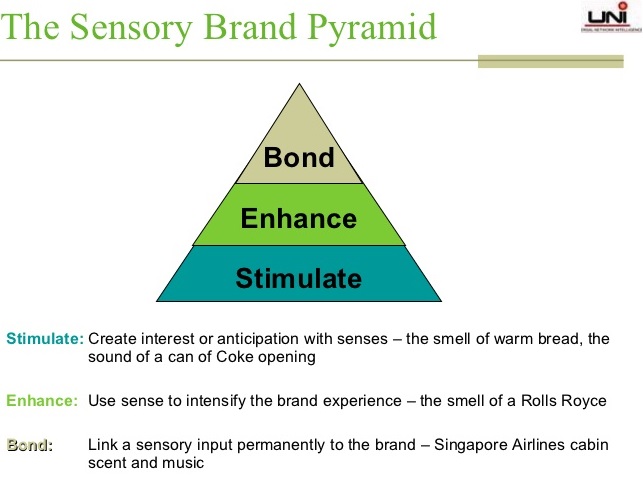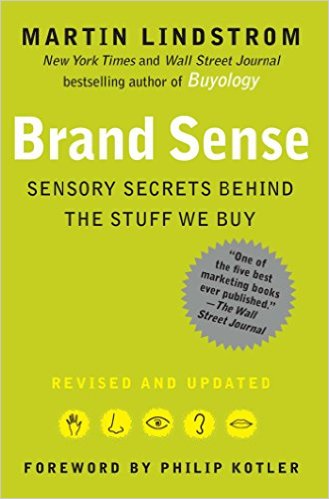
Multi-sensorial branded luxury in SIA’s first class cabin (courtesy of Richard Moross)
What do leading brands like Apple Computer, Singapore Airlines and Disney have in common?
Answer? These brands represent some of the world’s most multi-sensory brands.
Well, at least according to Martin Lindstrom, author of the book Brand Sense – Build Power Brands through Touch, Taste, Smell, Sight and Sound.
This highly readable volume on creating immersive brand experiences taught me a couple of things:
- Truly great brands do not just leverage on sight and sound (the most frequently branded elements)
- Brands which leave the most lasting impressions are those which focus heavily on the other three senses – smell, touch and taste
- Scent, touch and taste are far more deeply rooted in our mental and emotional psyche than sight or sound
So how do these top brands do it?
Can Your Brand Be Smashed?
To build a multi-sensory brand, you’ll first need to look at how you can smash your brand.
Now this certainly doesn’t mean that you turn violent. Nor should you destroy all copies of your prized Elvis or Ebisu collection.
Rather, you should try to develop such strong sensory values in your brand that each individual element can be recognised independent of the rest.
In Lindstrom’s book, the 12 components of the Smash Your Brand philosophy are as follows:
- Picture
- Colour
- Shape
- Name
- Language
- Icon
- Sound
- Behaviour
- Service
- Tradition
- Ritual
- Navigation
An example of a successful brand that can be smashed? The ubiquitous Coke bottle. Even when broken into pieces, each piece can still be individually recognised as part of the Coca-Cola brand. Melodies like Nokia’s signature tune or Intel’s jingle can also be recognised without the need to include a visual element.
Moving Up the Sensory Brand Pyramid
OK, you’re convinced about the importance of building a brand for your customer’s senses. How then should you evaluate how sensorial your brand is?
The book cites that you need to move up a pyramid that progresses from Stimulate to Enhance to Bond. This can be represented by the diagram below:
Courtesy of Uni Training Singapore
Greater degrees of brand smashability and customer loyalty will be forged as your brand moves up the ranks. From a brand that can achieve branded stimuli (touch, taste, scent, sound, sight), create branded enhancements (eg the tactile feel of keys on a Texas Instruments calculator) to finally bonding with customers (eg IBM ThinkPad’s navigation system, or Nokia’s cell-phone menu).
By the time you’ve reached the bonding stage, the brand sense process has become an intuitive and natural part of your customer’s everyday life.
Six Step process to Developing Sensory Brand
How can you develop a sensory brand?
Lindstrom proposed a six step strategy to develop a sensory brand.
Step 1: Conduct a sensory audit
This entails doing the following steps:
- Leverage existing sensory touch points (sight, sound, scent, taste, touch)
- Create synergy across them (eg combine right sound and taste)
- Use innovative sensory thinking to stay ahead of the competition
- Ensure sensory consistency and authenticity
- Confirm that sensory elements are positive
- Develop constant progress across touch points
- Determine if your brand is smashable (see above)
Step 2: Brand Staging
This involves doing a benchmarking exercise with sensory leaders in various categories, which may or may not hail from one’s industry, and comparing how one’s brand matches against theirs.
The best practices used by these leaders can be employed with modifications to your product or service.
Step 3: Brand Dramatisation
Like theatre, brands need to have a personality in order to move one’s feelings and emotions.
To do so, ask yourself the following questions:
- Can the various sensory elements help to convey the values of the brand?
- Are they able to effect the right stimuli, or enhance the existing virtues of the brand?
- Can the brand bond with its customers?
- Can sensory extensions help to develop a deeper linkage amongst the senses? For example, the distinct smell and taste of Colgate toothpaste can be extended across other products like dental floss and toothpicks.
Step 4: Brand Signature
This is the unique quality of the brand that cannot be easily replicated by competitors.
An example is the roar of the Harley Davidson motorcycles, the aromas of cookies baked by Famous Amos, or the smooth feel and lines of MacBooks.
Step 5: Implementation
This is where the rubber (or its burnt smell) hits the road. This consists of a five-step process:
- Develop sensory touch points: Which are the ones that will work best, and can be branded – stimuli, enhancement or bonding?
- Test concepts of sensory touch points using internal or external test subjects
- Integrate the different touch points
- Test with prototypes
- Conduct a natural environment study (ie a reality check away from the research lab)
Step 6: Evaluate Revised Sensory Brand and Impact
This is the last stage where you’ll test how effective your sensory brand is, based on the brand audit factors highlighted above.
Building Religious Brands
In one of the more fascinating chapers in the book, Martin illuminated readers on why the best sensorial or holistic brands in the world belong to the realm of religion.
As companies move towards building strong cult brands (like Apple’s MacBook followers, or Coca-Cola’s legions of “coke addicts”), they could learn how to employ the tools of sensorial branding to emulate the following qualities of religion:
1) A unique sense of belonging and community. Being able to elicit a feeling of being part of a greater cause will help. An example is the creation of Linux and how its community was united by a common goal to create the best open source operating system to rival Microsoft’s juggernaut.
2) A sense of purpose, which can be embodied by a charismatic and visionary leader.
3) Taking power from your competitors. Most religions do have a common enemy. Uniting one’s followers (eg Apple versus Microsoft) helps in strengthening brand communities.
4) Authenticity. Being real and having a strong heritage.
5) Consistency and stability. This is ever more important in an uncertain and troubled world.
6) Perfect world. Creating a utopian end-state that is aspirational and inspirational for followers.
7) Sensory appeal. Employing the tools and techniques which I have earlier mentioned.
8) Rituals. How traditions can be moulded into practices that help reinforce brand beliefs.
9) Symbols. These can be very significant and iconic representations, eg flags, crucifixes and crescents.
10) Mystery. The sense of mystique (eg what happens after death) can be especially powerful in brand leadership.
A Guide to Building Multi-Sensory Brands
In the age of ever increasing visual and audio clutter, the way to achieve true competitive advantage may rest in developing a truly differentiated and multi-sensory brand.
Brand Sense presents a useful step towards understanding how our senses could be leveraged upon to develop enduring brands in the crowded consumer marketplace. Ideas that are within are useful in the realm of not only marketing, but product development, operations and customer service.



Great post. It is so easy for marketers to forget about the other senses. But scent is especially has a strong influence. Each scent carries particular memories and emotions with it and if you can tap into good memories and emotions you’ve done a good job.
Spot on! Branding isn’t just about an attractive logo, high traffic location or historical reputation. Branding is about the totality of all the senses involved in the entire business – can make or break customer loyalty, word-of-mouth promotion and image.